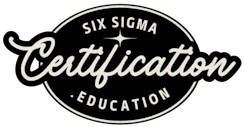Our Courses
6 Myths About Six Sigma Certification (and the Truth Behind Them)
Six Sigma has been recognized worldwide as one of the most effective approaches to process improvement and organizational excellence. Despite its success, many professionals remain hesitant about pursuing certification because of common myths and misconceptions.
These misunderstandings often prevent people from realizing the benefits Six Sigma can bring to their careers and to the organizations they serve. Below, we break down six of the most persistent myths about Six Sigma certification and reveal the truth behind them.
These misunderstandings often prevent people from realizing the benefits Six Sigma can bring to their careers and to the organizations they serve. Below, we break down six of the most persistent myths about Six Sigma certification and reveal the truth behind them.
Myth 1: Six Sigma is Only for Manufacturing
When Six Sigma first emerged, it was heavily associated with manufacturing because the earliest projects focused on reducing defects on production lines. This has led many to believe that Six Sigma is only relevant to factories or assembly plants.
In reality, Six Sigma principles apply to any industry where processes exist. From healthcare and finance to technology, government, and retail, the tools of Six Sigma can improve efficiency, reduce errors, and enhance customer satisfaction across the board.
The Truth: Six Sigma is industry-neutral. Any organization with workflows, customers, and measurable outcomes can benefit from its methods.
In reality, Six Sigma principles apply to any industry where processes exist. From healthcare and finance to technology, government, and retail, the tools of Six Sigma can improve efficiency, reduce errors, and enhance customer satisfaction across the board.
The Truth: Six Sigma is industry-neutral. Any organization with workflows, customers, and measurable outcomes can benefit from its methods.
Myth 2: It’s Too Complicated for Everyday Professionals
Myth 3: Six Sigma is Just About Reducing Costs
Myth 4: Certification is Only for Managers or Executives
Myth 5: Six Sigma Projects Take Too Long to Show Results
Myth 6: Certification Doesn’t Add Real Career Value
Frequently asked questions
How long does it take to get certified?
Most people complete a Six Sigma course in 7-10 days. Many people complete their program in just a few hours!
Is everything really included?
Yes! There is nothing else to buy. You get the training material and the certification exam.
Do I get a certificate when I complete a program?
Yes, you'll have instant access to your digital certificate. For paid certification programs, you'll also receive a professional digital badge and iPhone/Android Digital Wallet Card that you can add to your phone as proof of certification at any time!

